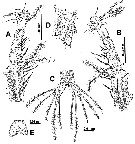|
|
 |
Fiche d'espèce de Copépode |
|
|
Monstrilloida ( Ordre ) |
|
|
|
Monstrillidae ( Famille ) |
|
|
|
Caromiobenella ( Genre ) |
|
|
| |
Caromiobenella pygmaea (Suarez-Morales, 2000) (M) | |
| | | | | | | Syn.: | Monstrilla pygmaea Suarez-Morales, 2000 | | | | Ref.: | | | Suarez-Morales, 2000 (p.112, Descr.M, figs.M); Vives & Shmeleva, 2010 (p.183, figs.M, Rem.) |  issued from : E. Suarez-Morales in Bull. Inst. R. Sci. nat. Belgique, Biologie, 70, 2000. [p.113, Fig.4]. Male (from Toulon Harbor, Mediterranean Sea): A-B, habitus (dorsal and lateral, respectively); C, P1; D, P2; E, P3. Nota: Cephalothorax representing slightly over 40 % of total body length. Oral papilla not prominent, located medially at about 41 % of way back along ventral surface of cephalothorax.Dorsal ocelli present, pigment cups relatively large, poorly developed, relatively close from each other. Low, rounded protuberance located between the antennula basesr and the oral papilla (visible in lateral view). A1 5-segmented, representing close to 41 % of total body length, and about 96 % as long as cephalothorax; P5 absent. Genital complex with a wide cylindrical base, terminal portion with 2 branches, both with denticulated posterior margin. Urosome consisting of 5 somites (5th pedigerous without appendage, genital complex and 3 free somites); ratio of lengths of genital somite and three free posterior somites 31.8:27.4:27.5: 12.3 = 100.
|
 issued from : E. Suarez-Morales in Bull. Inst. R. Sci. nat. Belgique, Biologie, 70, 2000. [p.114, Fig.5]. Male: A, left A1 (dorsal); B, right A1 (dorsal); C, caudal rami (dorsal); D, P4; E, terminal portion of genital lappets (anterior view). Nota: Caudal ramiabout 1.3 times longer than wide, with 3 well developed terminal setae, plus an additional one on distal inner marguin, and another on outer margin.
| | | | | NZ: | 1 | | |
|
Carte de distribution de Caromiobenella pygmaea par zones géographiques
|
| | | | | | | Loc: | | | W Medit. (Toulon Harbour) | | | | N: | 1 | | | | Lg.: | | | (828)* M: 0,43; {M: 0,43}
* caudal rami excluded. | | | | Rem.: | In vertical haul 0-22 m.
For Suarez-Morales (2000 c, p.114-115) this species is very closely related to M. helgolandica Claus, 1863, and to M. serricornis Sars, 1921.
For Jeon, Lee & Soh (2018, p.47) this species belongs to the new genus Caromiobenella, therefore it is a comb. nov. | | | Dernière mise à jour : 07/01/2025 | |
|
|
 Toute utilisation de ce site pour une publication sera mentionnée avec la référence suivante : Toute utilisation de ce site pour une publication sera mentionnée avec la référence suivante :
Razouls C., Desreumaux N., Kouwenberg J. et de Bovée F., 2005-2025. - Biodiversité des Copépodes planctoniques marins (morphologie, répartition géographique et données biologiques). Sorbonne Université, CNRS. Disponible sur http://copepodes.obs-banyuls.fr [Accédé le 03 juillet 2025] © copyright 2005-2025 Sorbonne Université, CNRS
|
|
 |
 |





